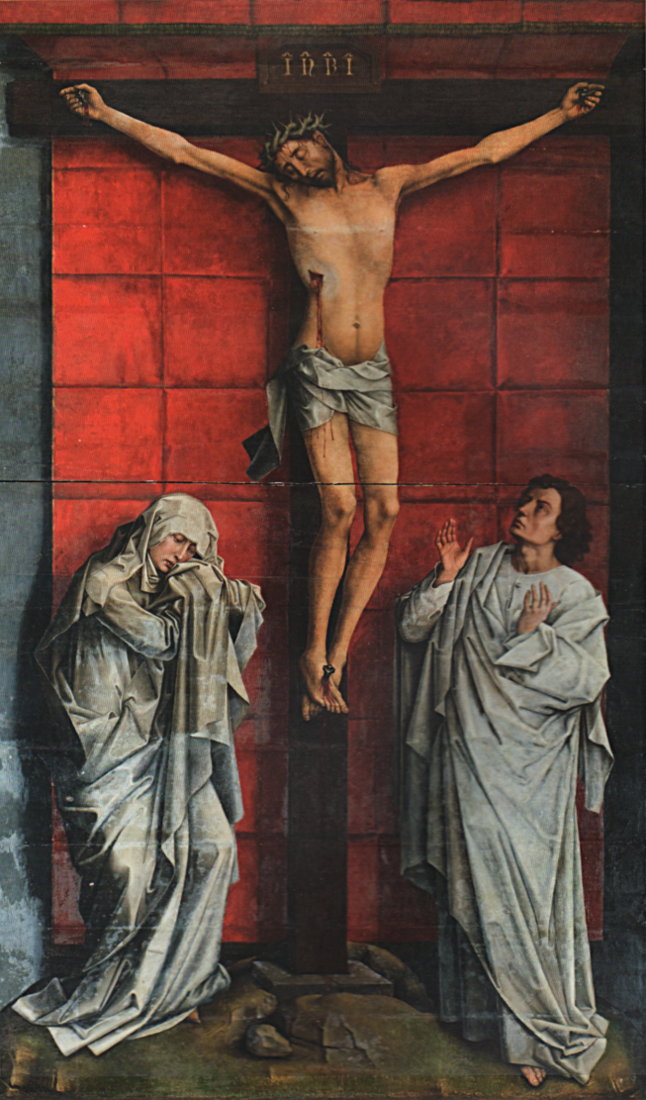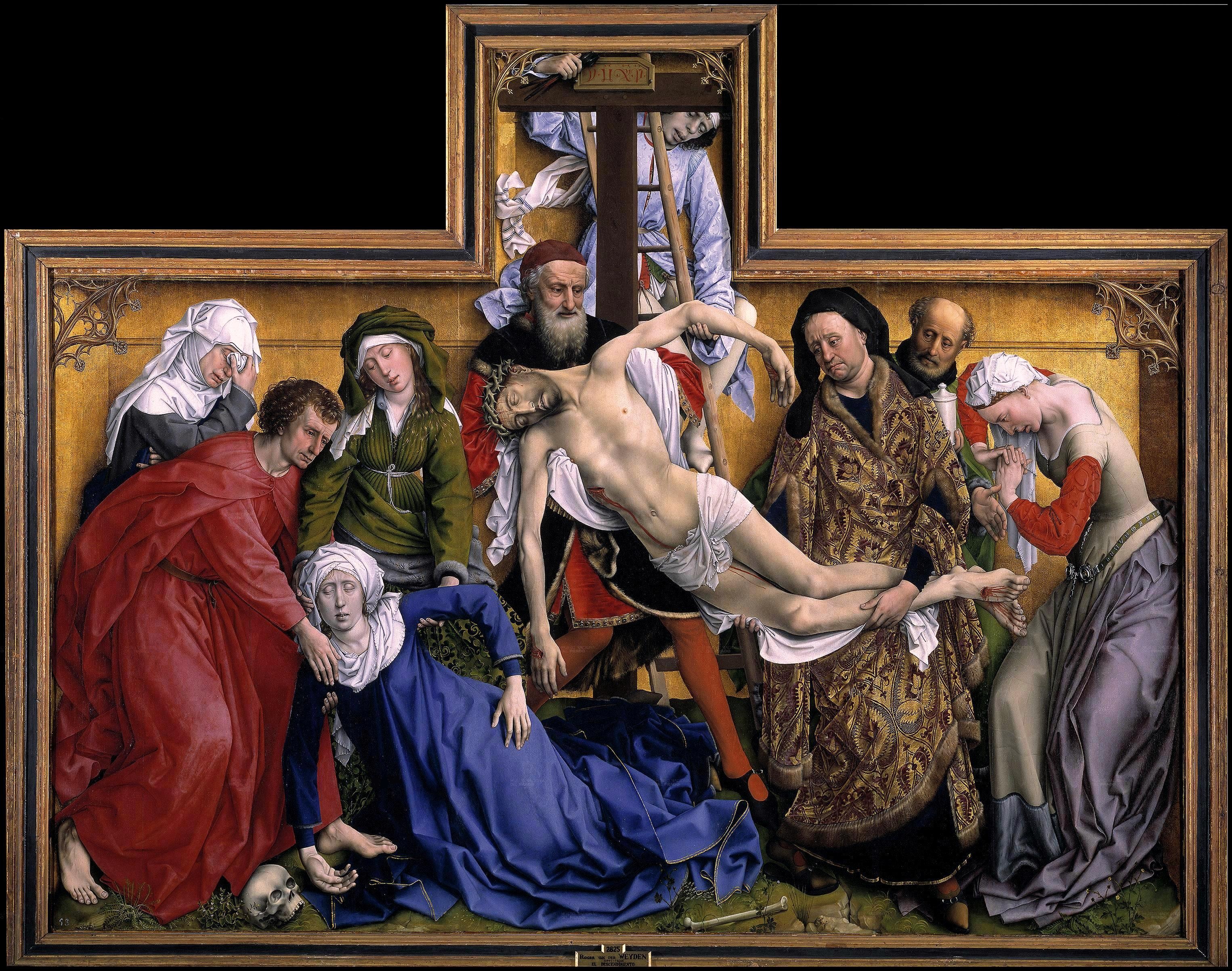- March 24 to June 28, 2015
This show celebrates the completion of the work to restore the
Calvary,
which was carried out under a collaboration agreement signed in 2011 by Patrimonio Nacional and the Museo Nacional del Prado to exhibit the work at the Prado for three months before it returns to El Escorial. This restoration project also involved the collaboration of Fundación Iberdrola as a benefactor member of the Museo del Prado’s restoration programme. This masterpiece of fifteenth-century Flemish painting was a gift from Van de Weyden himself to Scheut charterhouse (Brussels) shortly before his death and later, in 1574, it was officially delivered to the Monastery of San Lorenzo de El Escorial.
In addition to the Calvary, this exhibition features the
Descentfrom the Cross
executed for the church of Our Lady Outside the Walls in Louvain and housed in the Museo del Prado, and
the Miraflores Triptych,
a gift from King John II of Castile to the charterhouse of Miraflores in Burgos and now owned by the Gemäldegalerie in Berlin. These three works, the only ones in Spain at an early date and regarded as autograph, have been brought together in this exhibition for the first time in history.
They will be joined by one of the sculptural groups of the so-called
Bethlehem Altarpiece
from the church of Santa María de la Asunción in Laredo, executed in Brussels around 1440, in order to provide a fascinating visual contrast both between the figures in this work, which are very similar to those of the Descent and the Calvary, and between the small reliefs on the archivolts, which resemble those of the Miraflores Triptych.
This show also allows visitors to view the iconographical theme of the Calvary in other works painted by the artist or linked to his workshop, such as the
Altarpiece of the Seven Sacraments
from the Koninklijk Museum in Antwerp, one of Van der Weyden’s most exquisite original works. The work inspired the version produced by one of his direct followers: the Master of the Prado Redemption who is named after his culminating work, the Triptych of the Redemption, whose central panel, the Crucifixion, can be seen in this exhibition.
The show also underlines the significance of the artist’s patrons and contemporary collectors who regarded his creations highly. It features the portraits of Philip the Good and his son Charles the Bold, which appear in a Florentine historical manuscript and are copies of originals by Van der Weyden.
Isabella of Portugal, wife and mother of these two dukes of Burgundy, was also an important patron of Rogier van der Weyden, as revealed by the portrait commissioned from the artist and housed in the J. Paul Getty Museum in Los Angeles and the large altarpiece she commissioned for the monastery of Santa María de la Victoria (Batalha), which was sent to Lisbon in 1445. This portrait, no longer extant, is known solely through a drawing of 1808 that can also be seen in the exhibition.
Visitors can also view the tapestry of the Story of Jephthah from the Museo Diocesiano in Zaragoza, which is based on models by Van der Weyden and may have belonged to Pedro, Constable of Portugal (d. 1466), or to Juana Enríquez (d. 1468), Ferdinand the Catholic’s mother.
Copies and versions of works by Van der Weyden were also highly appreciated from very early on in the Iberian Peninsula.
The Prado Virgin and Child, also called the Durán Madonna
and another salient piece in the show, was known in Spain in the artist’s lifetime because it was widely copied in the fifteenth century, as exemplified by the version by the Master of Don Álvaro de Luna in Castile.
Isabella the Catholic commissioned her court painter, Juan de Flanders, to paint a copy of the Miraflores Triptych for the Royal Chapel of Granada, one of the panels of which is on display, lent by the Metropolitan Museum in New York.
The powerful impact of Van der Weyden’s creations in the Iberian Peninsula also enjoys a significant presence in the show; it is visible in the work by the Portuguese Nuno Gonçalves and especially in the compositions by Egas Cueman, a sculptor of Flemish origin by whom several drawings for a tomb are shown here, clearly inspired by Van de Weyden’s compositions. Egas Cueman also crafted the outstanding funerary sculpture of Lope de Barrientos, confessor to John II of Castile and bishop of Ávila, Segovia and Cuenca. It is the piece that best expresses the artist’s technical mastery at handling a material as fragile as alabaster and is one of the gems of Rogier van der Weyden’s exquisite aesthetic in fifteenth-century Castile; it had not previously been lent.




